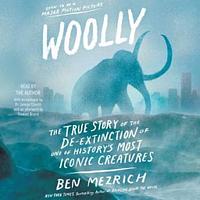Take a photo of a barcode or cover
171 reviews for:
Woolly: The True Story of the Quest to Revive One of History's Most Iconic Extinct Creatures
Ben Mezrich
171 reviews for:
Woolly: The True Story of the Quest to Revive One of History's Most Iconic Extinct Creatures
Ben Mezrich
adventurous
informative
fast-paced
It’s been a year and a half and I finally finished this book! This book means a lot to me personally because it introduced me to genetically engineering during my college app season. Now, as a college freshman, I finished this book to see the ethical issues involved in the process of reviving woolly mammoths. Many people might argue that the “exaggerated narrative” might be a little uncomfortable, but I think it is this type of narrative that opened a door for me about the process of scientific research. I do get that some part of the narrative lacks consistency but I think it does a well job documenting the process of the woolly mammoth revival project.
Just so we’re all on the same page, this is a non-fiction book about geneticists attempting to resurrect the woolly mammoth. Do you hear me!? There are scientists collecting DNA from frozen woolly mammoths with the intention of reintroducing an extinct species. Do you know how many times I double-checked to make sure this was actually a non-fiction book? I Googled its Dewey decimal number and sure enough those 591 books are specific topics in zoology. Do you know what did not increase my confidence that this was a trusty worthy book? The 1990s boy band author photo of Ben Mezrich with steam punk leanings (you can view it here: www.themusichall.org/assets/uploads/images/11_07_Mezrich_new_home.jpg).
There are more recent pictures of this man and yet this is the one found in his 2017 publication.
Our protagonist Dr. George Church leads the Personal Genome Project at Harvard. Check out this clip from the Colbert Report, he’s pretty interesting: http://www.cc.com/video-clips/fkt99i/the-colbert-report-george-church.
Our bad guys, so to speak, are a famously disgraced cloning team from South Korea: https://www.nytimes.com/2014/03/01/world/asia/scientists-new-project-rebuild-after-cloning-disgrace.html?rref=collection%2Ftimestopic%2FHwang%20Woo%20Suk&action=click&contentCollection=timestopics®ion=stream&module=stream_unit&version=latest&contentPlacement=2&pgtype=collection
And now on to the book, Ben Mezrich takes some significant liberties with his creative use of non-fiction. For example, the first chapter takes place “three thousand years ago” and is about man’s first encounter with the woolly mammoth, which ultimately leads to their demise (the mammoths, not man). Chapter two skips to “four years from today …” Let’s just say there’s a lot going on here. Mezrich does a great job of making the science of genetics not only readable but enjoyable for the lay reader. And of course, did I mention woolly mammoths!?
Not sure if it’s the kid in me that finds this exciting but what a way to get your average reader interested in science.
Now, who’s excited!? https://www.youtube.com/watch?v=zEZBeR1Mywk
There are more recent pictures of this man and yet this is the one found in his 2017 publication.
Our protagonist Dr. George Church leads the Personal Genome Project at Harvard. Check out this clip from the Colbert Report, he’s pretty interesting: http://www.cc.com/video-clips/fkt99i/the-colbert-report-george-church.
Our bad guys, so to speak, are a famously disgraced cloning team from South Korea: https://www.nytimes.com/2014/03/01/world/asia/scientists-new-project-rebuild-after-cloning-disgrace.html?rref=collection%2Ftimestopic%2FHwang%20Woo%20Suk&action=click&contentCollection=timestopics®ion=stream&module=stream_unit&version=latest&contentPlacement=2&pgtype=collection
And now on to the book, Ben Mezrich takes some significant liberties with his creative use of non-fiction. For example, the first chapter takes place “three thousand years ago” and is about man’s first encounter with the woolly mammoth, which ultimately leads to their demise (the mammoths, not man). Chapter two skips to “four years from today …” Let’s just say there’s a lot going on here. Mezrich does a great job of making the science of genetics not only readable but enjoyable for the lay reader. And of course, did I mention woolly mammoths!?
Not sure if it’s the kid in me that finds this exciting but what a way to get your average reader interested in science.
Now, who’s excited!? https://www.youtube.com/watch?v=zEZBeR1Mywk
This book is a wonderful way of expressing the challenges of being a scientist.
3.5 stars. I wish this was written a little more factually and with a little less imagination/conjecture. The science was really interesting and I hope to hear more in the future about the various projects mentioned.
adventurous
hopeful
lighthearted
medium-paced
This is a fascinating look at the work being done to "revive" the Woolly Mammoth. Mr. Mezrich makes understanding the complex science behind this effort easy. It reads like a fast paced fiction thriller. I was a little confused as to what was fact or fiction in the first couple of chapters because I came into this knowing nothing about the project and had to look up some facts. This might not have been the case if I was reading a paper copy instead of an ebook and could have flipped back a few pages as I was reading. I think anyone with an interest in science or nature would enjoy reading this book.
I received a digital advanced reader’s copy in exchange for an honest review
I received a digital advanced reader’s copy in exchange for an honest review
I thought the book would bring more new information to me than it did. Still it was interesting.
Best one sentence review I can give of this book is that it is a mix of Jurassic Park and the Martian with the scientific realism of a documentary on Woolly Mammoths and Al Gore's Inconvenient Truth.
Ultimately I think it tries to be something more than that, but that said I can see the influences of these things everywhere I look in the book. The book tries, and ultimately fails in my opinion, to tell a fictionalized story surrounding the real life people working to resurrect the Woolly Mammoth. Because of this it often straddles the line between fiction and nonfiction. Most of it is real (at least I assume) true life events, but ultimately it left me wanting for a compelling story.
It starts off postulating how we could resurrect the Woolly Mammoth, and begins showcasing several key characters in the story as well as a compelling plot as to why it is vital we do this. Like any good fiction book, it begins to get me invested into the story and the main people involved. But then it suddenly veers right, adhering to the nonfiction realism of it's source material. Characters introduced are simply dropped halfway through because I guess they left the project. Characters you are invested in are never fully "explored" because they are real people. The Drama and the conflict of the story are de-escalated and left to anti-climactic endings because that is just how the story progressed in real life. It just leaves me frustrated.
Perhaps I went into this book not fully understanding the background to what I was reading. But this story seems to want to be so much more than it is. It reads like it is about to set off on an amazing journey to replicate a Woolly Mammoth a la Jurassic Park, and that it is about a team of scientist racing against the clock to prevent a catastrophe and rescue humanity a la the Martian. However, just when you are on the edge of your seat waiting for the next big twist, it turns into a quagmire of unfulfilling resolutions and "plot holes" that are never addressed again.
This book fails because of the set up it has in it's structure, trying to be a nonfiction book written like fiction. The nonfiction loving side of me is disappointed because it is not written third person objectively, and the fiction side is disappointing because it constantly has disappointing payoffs due to the "True Story" aspects. It just doesn't work for me.
It is a well written book, and it does take the science very seriously which I definitely appreciated while reading this. It generated honest desire in me to learn more about biology and the bio-engineering it talks about. But as a narrative it just leaves the reader wanting. I've read plenty of Historical fiction before, so I am used to authors making good use of real life events in a fictionalized setting. But this book just doesn't do it as well as I hoped it would, which is a shame because I think if Mr. Mezrich had just committed more to one side or the other (fiction or nonfiction) this book would have been absolutely spectacular! As it stands it is a camel (a horse developed by compromise) something that is readable, but not at all memorable.
Ultimately I think it tries to be something more than that, but that said I can see the influences of these things everywhere I look in the book. The book tries, and ultimately fails in my opinion, to tell a fictionalized story surrounding the real life people working to resurrect the Woolly Mammoth. Because of this it often straddles the line between fiction and nonfiction. Most of it is real (at least I assume) true life events, but ultimately it left me wanting for a compelling story.
It starts off postulating how we could resurrect the Woolly Mammoth, and begins showcasing several key characters in the story as well as a compelling plot as to why it is vital we do this. Like any good fiction book, it begins to get me invested into the story and the main people involved. But then it suddenly veers right, adhering to the nonfiction realism of it's source material. Characters introduced are simply dropped halfway through because I guess they left the project. Characters you are invested in are never fully "explored" because they are real people. The Drama and the conflict of the story are de-escalated and left to anti-climactic endings because that is just how the story progressed in real life. It just leaves me frustrated.
Perhaps I went into this book not fully understanding the background to what I was reading. But this story seems to want to be so much more than it is. It reads like it is about to set off on an amazing journey to replicate a Woolly Mammoth a la Jurassic Park, and that it is about a team of scientist racing against the clock to prevent a catastrophe and rescue humanity a la the Martian. However, just when you are on the edge of your seat waiting for the next big twist, it turns into a quagmire of unfulfilling resolutions and "plot holes" that are never addressed again.
This book fails because of the set up it has in it's structure, trying to be a nonfiction book written like fiction. The nonfiction loving side of me is disappointed because it is not written third person objectively, and the fiction side is disappointing because it constantly has disappointing payoffs due to the "True Story" aspects. It just doesn't work for me.
It is a well written book, and it does take the science very seriously which I definitely appreciated while reading this. It generated honest desire in me to learn more about biology and the bio-engineering it talks about. But as a narrative it just leaves the reader wanting. I've read plenty of Historical fiction before, so I am used to authors making good use of real life events in a fictionalized setting. But this book just doesn't do it as well as I hoped it would, which is a shame because I think if Mr. Mezrich had just committed more to one side or the other (fiction or nonfiction) this book would have been absolutely spectacular! As it stands it is a camel (a horse developed by compromise) something that is readable, but not at all memorable.





